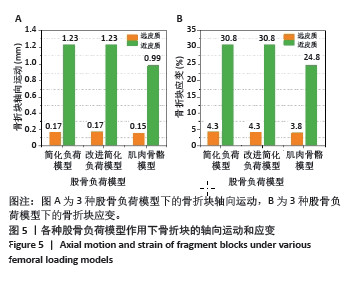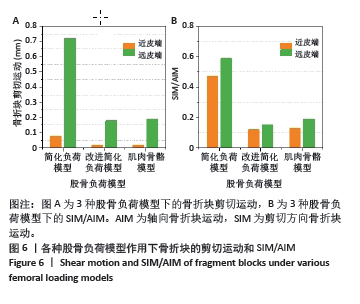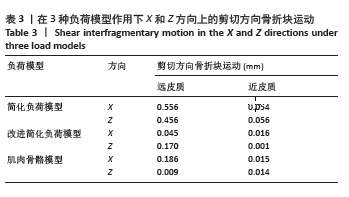[1] MA Q, MIRI Z, HAUGEN HJ, et al. Significance of mechanical loading in bone fracture healing, bone regeneration, and vascularization. J Tissue Eng. 2023;14:204173142311725.
[2] ELKINS J, MARSH JL, LUJAN T, et al. Motion Predicts Clinical Callus Formation: Construct-Specific Finite Element Analysis of Supracondylar Femoral Fractures. J Bone Joint Surg Am. 2016;98(4):276-284.
[3] VAUGHN JE, SHAH RV, SAMMAN T, et al. Systematic review of dynamization vs exchange nailing for delayed/non-union femoral fractures. World J Orthop. 2018;9(7):92-99.
[4] MIRAMINI S, GANADHIEPAN G, LIN YC, et al. Influence of muscle loading on early-stage bone fracture healing. J Mech Behav Biomed Mater. 2023;138:105621.
[5] LI L, LIU X, PATEL M, et al. Depth camera-based model for studying the effects of muscle loading on distal radius fracture healing. Comput Biol Med. 2023;164:107292.
[6] MEENA VK, KUMAR M, PUNDIR A, et al. Musculoskeletal-based finite element analysis of femur after total hip replacement. Proc Inst Mech Eng H. 2016;230(6):553-560.
[7] GAZIANO P, FALCINELLI C, VAIRO G. A computational insight on damage-based constitutive modelling in femur mechanics. Eur J Mech A Solids. 2022;93:104538.
[8] SCHILEO E, TADDEI F. Finite Element Assessment of Bone Fragility from Clinical Images. Curr Osteoporos Rep. 2021;19(6):688-698.
[9] 史方石, 袁维. 有限元法在骨科器械和植入物中的应用综述[J]. 科学技术与工程,2023,23(30):12775-12785.
[10] AHIRWAR H, GUPTA VK, NANDA HS. Finite element analysis of fixed bone plates over fractured femur model. Comput Methods Biomech Biomed Engin. 2021;24(15):1742-1751.
[11] BAI GY, XU XH, WANG JH, et al. Single-leg weight limit of fixation model of simple supracondylar fracture of femur. Acta Mech Sin. 2019;35(4): 926-939.
[12] MATHUKUMAR S, NAGARAJAN V, RADHAKRISHNAN A. Analysis and validation of femur bone data using finite element method under static load condition. Proc Inst Mech Eng C J Mech Eng Sci. 2019;233(16): 5547-5555.
[13] WANG Y, MA J, YIN T, et al. Correlation Between Reduction Quality of Femoral Neck Fracture and Femoral Head Necrosis Based on Biomechanics. Orthop Surg. 2019;11(2):318-324.
[14] CHEN X, MYERS CA, CLARY CW, et al. Development of axial compression and combined axial compression and torque loading configurations to reproduce strain in the implanted femur during activities of daily living. J Biomech. 2021;120:110363.
[15] WEE H, REID JS, CHINCHILLI VM, et al. Finite Element-Derived Surrogate Models of Locked Plate Fracture Fixation Biomechanics. Ann Biomed Eng. 2017;45(3):668-680.
[16] CHANDRA G, PANDEY A. Biomechanical evaluation on a novel design of biodegradable embossed locking compression plate for orthopaedic applications using finite element analysis. Biomech Model Mechanobiol. 2022;21(5):1371-1392.
[17] DHASON R, ROY S, DATTA S. A biomechanical study on the laminate stacking sequence in composite bone plates for vancouver femur B1 fracture fixation. Comput Methods Programs Biomed. 2020;196: 105680.
[18] XIONG B, YANG P, LIN T, et al. Changes in hip joint contact stress during a gait cycle based on the individualized modeling method of “gait-musculoskeletal system-finite element”. J Orthop Surg Res. 2022;17(1): 267.
[19] ZHANG Q, PENG Y, CHEN Z, et al. Conformity design can change the effect of tibial component malrotation on knee biomechanics after total knee arthroplasty. Clin Biomech (Bristol, Avon). 2023;105: 105985.
[20] RIEGER F, ROTHENFLUH DA, FERGUSON SJ, et al. Comprehensive assessment of global spinal sagittal alignment and related normal spinal loads in a healthy population. J Biomech. 2024; 170:112127.
[21] ZHANG Q, CHEN Z, PENG Y, et al. The novel magnesium–titanium hybrid cannulated screws for the treatment of vertical femoral neck fractures: Biomechanical evaluation. J Orthop Translat. 2023;42:127-136.
[22] 范勋健, 陈瑱贤, 曹卓, 等. 个体化骨肌多体动力学和有限元联合建模的肩胛骨锁定板生物力学评估方法[J]. 西安交通大学学报, 2019,53(7):168-176.
[23] 罗林聪, 马立敏, 林泽, 等. 基于AnyBody骨骼肌肉多体动力学分析的有限元仿真[J]. 医用生物力学,2019,34(3):237-242+250.
[24] JIAN‐QIAO PENG M, CHEN C, MA L, et al. Dynamic effect of three locking plates fixated to humeral fracture based on multibody musculoskeletal model. Int J Med Robot. 2021;17(6):e2323.
[25] PENG MJ, JU X, MA L, et al. Dynamics analysis for flexion and extension of elbow joint motion based on musculoskeletal model of Anybody. Int J Med Robot. 2021;17(6):e2321.
[26] FAN X, CHEN Z, JIN Z, et al. Parametric study of patient-specific femoral locking plates based on a combined musculoskeletal multibody dynamics and finite element modeling. Proc Inst Mech Eng H. 2018; 232(2):114-126.
[27] HEYLAND M, TREPCZYNSKI A, DUDA GN, et al. Selecting boundary conditions in physiological strain analysis of the femur: Balanced loads, inertia relief method and follower load. Med Eng Phys. 2015;37(12): 1180-1185.
[28] BAGHERI ZS, TAVAKKOLI AVVAL P, BOUGHERARA H, et al. Biomechanical Analysis of a New Carbon Fiber/Flax/Epoxy Bone Fracture Plate Shows Less Stress Shielding Compared to a Standard Clinical Metal Plate. J Biomech Eng. 2014;136(9):091002.
[29] COQUIM J, CLEMENZI J, SALAHI M, et al. Biomechanical Analysis Using FEA and Experiments of Metal Plate and Bone Strut Repair of a Femur Midshaft Segmental Defect. Biomed Res Int. 2018;2018:1-11.
[30] DUBOV A, KIM SYR, SHAH S, et al. The biomechanics of plate repair of periprosthetic femur fractures near the tip of a total hip implant: the effect of cable-screw position. Proc Inst Mech Eng H. 2011;225(9): 857-865.
[31] SHAH S, KIM SYR, DUBOV A, et al. The biomechanics of plate fixation of periprosthetic femoral fractures near the tip of a total hip implant: cables, screws, or both? Proc Inst Mech Eng H. 2011;225(9):845-856.
[32] BOUGHERARA H, ZDERO R, MIRIC M, et al. The biomechanics of the T2 femoral nailing system: A comparison of synthetic femurs with finite element analysis. Proc Inst Mech Eng H. 2009;223(3):303-314.
[33] WANG J, ZHANG X, LI S, et al. Plating System Design Determines Mechanical Environment in Long Bone Mid-shaft Fractures: A Finite Element Analysis. J Invest Surg. 2020;33(8):699-708.
[34] OEFNER C, HERRMANN S, KEBBACH M, et al. Reporting checklist for verification and validation of finite element analysis in orthopedic and trauma biomechanics. Med Eng Phys. 2021;92:25-32.
[35] 史金友, 肖玉周, 吴敏, 等. 微动本质及骨折愈合生物力学分期的研究[J]. 中国修复重建外科杂志,2021,35(9):1205-1211.
[36] 徐创业, 温俭, 董谢平. 轴向微动接骨板固定股骨骨折的生物力学有限元分析[J]. 现代仪器与医疗,2023,29(6):20-26.
[37] MEHBOOB A, MEHBOOB H, KIM J, et al. Influence of initial biomechanical environment provided by fibrous composite intramedullary nails on bone fracture healing. Compos Struct. 2017; 175:123-134.
[38] INACIO JV, SCHWARZENBERG P, KANTZOS A, et al. Rethinking the 10% strain rule in fracture healing: A distal femur fracture case series. J Orthop Res. 2023;41(5):1049-1059.
[39] CHENG C, ZHANG J, JIA J, et al. Influence of knee flexion on early femoral fracture healing: A combined analysis of musculoskeletal dynamics and finite elements. Comput Methods Programs Biomed. 2023;241:107757.
[40] SARWAR A, GEE A, BOUGHERARA H, et al. Biomechanical optimization of the far cortical locking technique for early healing of distal femur fractures. Med Eng Phys. 2021;89:63-72.
[41] GEE A, BOUGHERARA H, SCHEMITSCH EH, et al. Biomechanical design using in-vitro finite element modeling of distal femur fracture plates made from semi-rigid materials versus traditional metals for post-operative toe-touch weight-bearing. Med Eng Phys. 2021;87:95-103.
[42] DJURICIC A, GEE A, SCHEMITSCH EH, et al. Biomechanical design of a new percutaneous locked plate for comminuted proximal tibia fractures. Med Eng Phys. 2022;104:103801.
[43] SKUBICH J, PISZCZATOWSKI S. Model of loadings acting on the femoral bone during gait. J Biomech. 2019;87:54-63.
[44] 连晖, 丁晓红 , 焦古月, 等. 长骨类骨折内固定系统刚度和应力分布规律 [J] . 医用生物力学 ,2022,37(4):604-611. |




